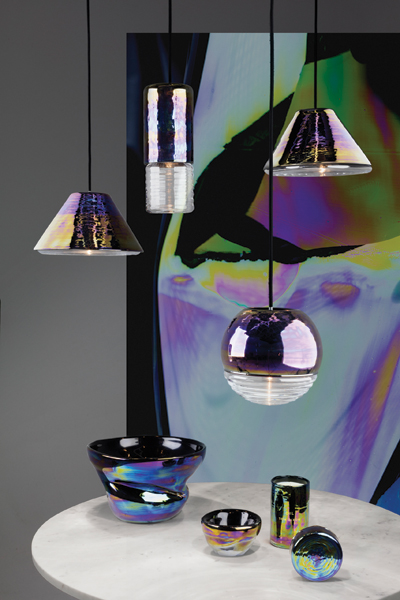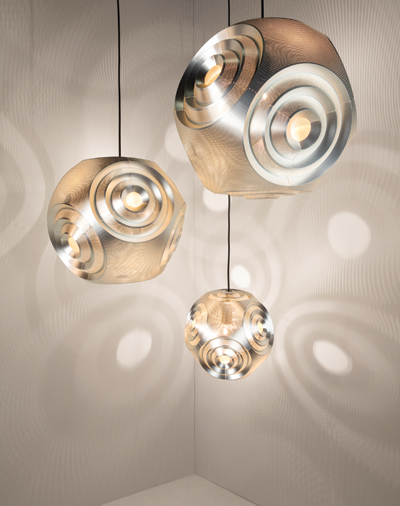|
|
||
|
The designer’s latest lighting collections – shown this week at Clerkenwell Design Week – find him in expansive mood, embracing new techniques and collaborators Sensuous, it turns out, is not the appropriate adjective for Tom Dixon’s latest lighting collections. Fade, Curve and Flask Oil were all presented in the baroque splendour of Milan’s Rotanda della Besana at Salone in April, and for each he rattles off alternative descriptions, having rejected my meagre offering.
Flask Oil uses iridescent black glass The elongated, upturned wine glass of Fade, Dixon characterises as ‘functional and contemporary’. Its metallised finish in gold or silver is familiar from mirrored sunglasses, but dissolves gently away as it descends the blow-moulded polycarbonate body, revealing the spotlight within. In contrast, the geometrical Curve, with its pattern of large concentric circles, seems retro from distance, but the nickel silver finish, and a host of tiny, light-emitting perforations (a process adapted from speaker grills), bring it bang up to date. According to Dixon, ‘It has a sensibility reminiscent of 1970s sci-fi films, but in fact it’s the product of countless exercises in 1950s paper-folding, which ended up littered all over the studio.’ Perhaps most eye-catching is Flask Oil, ‘a mixture of arts & crafts and industrial’. Three pendant lights mimic the shapes of laboratory vessels, each composed of two glass elements: a rippled, defracting lens attached to an oily, lustrous black shade that seems to eddy with purple and gold: ‘I’ve been exploring iridescence for a long time, so it’s great to finally find a manufacturer able to coat glass like this.’
Curve is a perforated metal lamp coated with nickel silver All bar Curve are being manufactured by new (and secret) partners, a pursuit of technical innovation he admits is driven, in part, by a desire to escape the tyranny of his signature copper. They also show a strong commercial acumen: ‘Venn diagrams are my favourite – finding that sweet spot where hospitality and domestic markets meet. Achieving the durability required for the former with the desirability of the latter, all at the right price point – it’s like trying to invent the Swiss Army knife.’ Which is not to say he’s upset to hear his creations described as sensuous: ‘It’s always interesting when collections acquire their own life outside the studio. That, and finding manufacturers willing to experiment, are payback for the hassle of distribution. So sensuous is fine by me.’ |
||



















